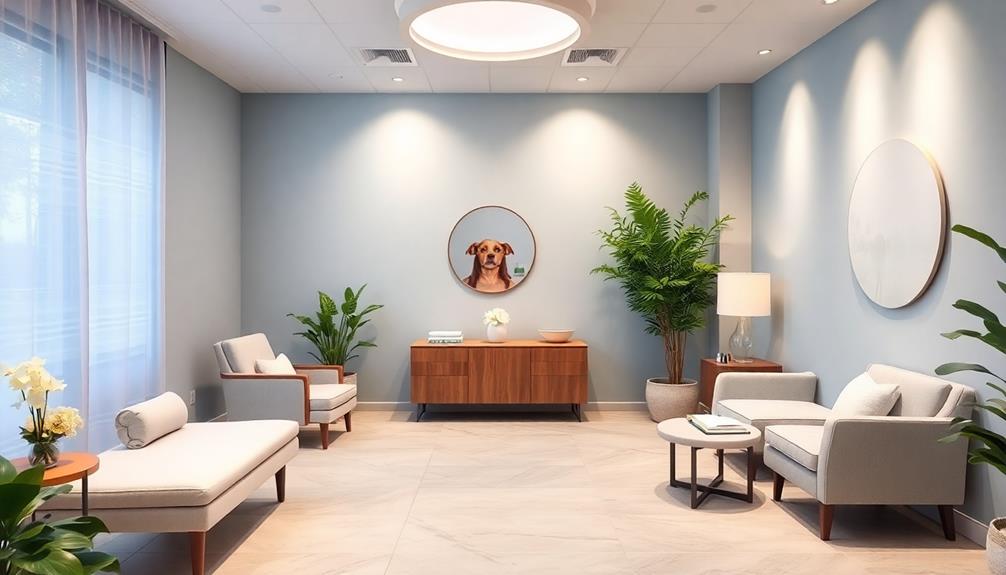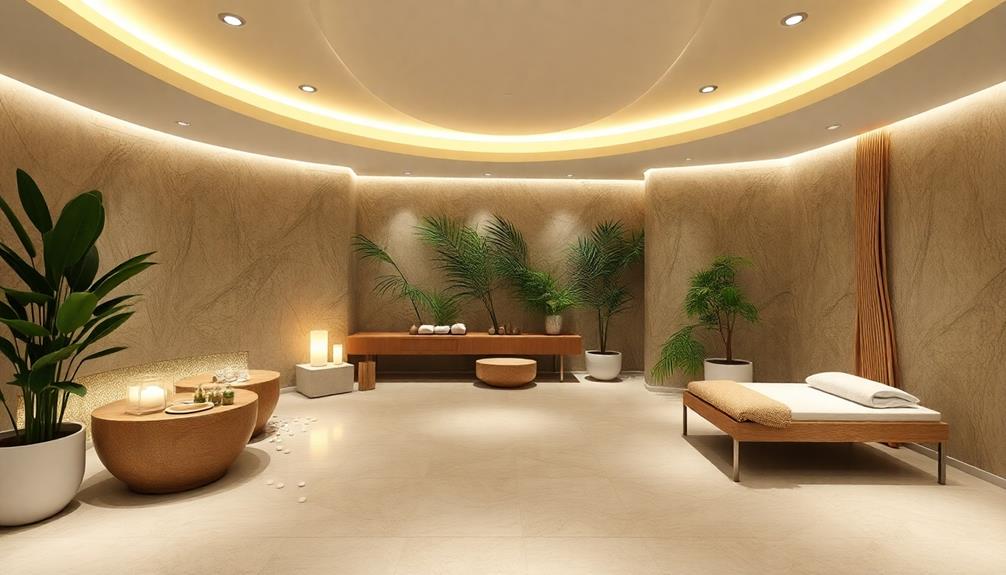Revolutionary trends in medical spa design are all about creating immersive experiences that prioritize wellness. You'll find natural elements like wood, stone, and water features that promote relaxation and a soothing atmosphere. Technology enhances treatment rooms with smart systems for personalized skincare. Color psychology plays a key role, as soft hues reduce stress and create inviting spaces. Sustainable practices guarantee eco-friendliness, aligning with clients' wellness goals. Plus, multi-sensory experiences, from sound therapy to aromatherapy, elevate the ambiance. If you're curious about how these trends can transform a medical spa, there's even more to discover!
Key Takeaways
- Integration of natural elements, such as wood and stone, enhances aesthetics and promotes a soothing atmosphere in medical spa designs.
- Advanced technology, including smart treatment rooms and biometric sensors, personalizes client experiences and optimizes treatment outcomes.
- Color psychology plays a crucial role, with soft blues and greens reducing stress and creating a relaxing environment for clients.
- Water features, like indoor fountains, provide calming sounds and improve air quality, enhancing overall wellness in spa settings.
- Emphasis on sustainability through eco-friendly materials and energy-efficient systems aligns with clients' wellness goals and supports environmental responsibility.
Natural Elements in Design

Incorporating natural elements in medical spa design not only enhances the aesthetic but also promotes a soothing atmosphere. You can use materials like wood, stone, bamboo, and cork to create warmth and comfort.
By implementing biophilic design principles, you'll foster relaxation and connection to nature. Consider adding water features, such as indoor fountains, to introduce calming sounds that further enhance tranquility.
Maximizing natural light and incorporating greenery won't only brighten the space but also contribute to overall well-being. This harmonious atmosphere encourages healing and restoration for your clients, making their experience more enjoyable.
Ultimately, integrating these natural elements transforms the spa into a serene sanctuary, inviting clients to unwind and rejuvenate.
Technology in Treatment Rooms

Modern medical spas are increasingly embracing technology in treatment rooms to elevate the client experience and optimize outcomes. You'll find smart treatment rooms equipped with personalized skincare analysis and biometric sensors, ensuring data-driven wellness enhancements. Imagine immersing yourself in VR relaxation experiences, transforming your journey into a soothing escape.
| Technology | Benefit |
|---|---|
| Smart Skincare Analysis | Personalized treatment plans |
| Biometric Sensors | Data-driven wellness insights |
| VR Relaxation | Immersive, calming experiences |
| AI Appointment Systems | Seamless scheduling and service |
Impact of Color Psychology

The atmosphere of a medical spa markedly influences client experiences, and color plays a pivotal role in shaping that environment.
You'll want to select soft blues and greens, as they're known to reduce stress and promote relaxation. Warm neutrals can create a cozy vibe, making clients feel at home.
By balancing vibrant colors with calming shades, you foster harmony that enhances the overall ambiance.
Consider adapting color schemes based on treatment areas; a serene palette in relaxation zones contrasts well with energizing colors in workout spaces.
This thoughtful approach enhances mood and encourages a sense of well-being, ultimately contributing to a more positive client experience.
In your design, remember that color isn't just aesthetic—it's a tool for healing.
Importance of Water Features

Water features play a crucial role in enhancing the atmosphere of a medical spa, offering both aesthetic appeal and therapeutic benefits. When you incorporate indoor fountains, the soothing sounds create a calming environment that encourages relaxation.
Visual elements like aquariums or water walls serve as focal points, drawing attention and promoting tranquility. These features also aid in improving air quality and humidity, which can enhance overall comfort.
By integrating water therapy areas, you provide clients with holistic healing options. The presence of water not only elevates the spa's design but also supports wellness, making it an essential element in your medical spa's ambiance.
Prioritizing these installations can greatly impact client satisfaction and their overall experience.
Emphasis on Sustainability

Sustainability has become an essential focus in medical spa design, as more clients seek eco-friendly options that align with their wellness goals. You can elevate your spa by integrating sustainable materials and energy-efficient systems. Opting for recycled elements and low-VOC finishes not only benefits the environment but also enhances client safety.
Here's a quick look at some sustainable practices you can adopt:
| Practice | Benefits | Examples |
|---|---|---|
| Eco-friendly materials | Promotes sustainability | Bamboo, recycled glass |
| Energy-efficient systems | Reduces operational costs | LED lighting, smart HVAC |
| Local sourcing | Supports community and economy | Partnering with local artisans |
Creating Zen Spaces

Creating Zen spaces is essential for fostering a serene environment where clients can truly unwind. Start by integrating natural elements like wood and stone to create warmth.
Incorporate biophilic design with plenty of greenery and natural light to enhance relaxation. Water features, such as indoor fountains, can add calming sounds and visual tranquility.
Use soft blues and greens in your color palette to reduce stress levels, while warm neutrals create a cozy atmosphere.
Consider designing meditation zones with minimalistic decor and comfortable textiles. Add aromatherapy diffusers to elevate the sense of peace.
Quiet rooms for solitude and nature-inspired art can further enhance the calming experience, allowing clients to feel rejuvenated and restored during their time at the spa.
Enhancing Multi-Sensory Experiences

To enhance the multi-sensory experience at your medical spa, focus on engaging all five senses to promote relaxation and well-being.
Start with sound therapy; soothing music or nature sounds can create a calming atmosphere. For touch, incorporate textured walls and soft furnishings, inviting guests to explore their surroundings.
Lighting design is essential—utilize adjustable lighting to shift moods throughout the day. Visually, display nature-inspired art and maintain views of greenery to soothe the eyes.
Finally, scent therapy can elevate the experience; use essential oil diffusers to fill the air with calming aromas.
Frequently Asked Questions
How Do Community Spaces Enhance Patient Experience in Medical Spas?
Community spaces enhance your experience by fostering connections with others, providing a sense of belonging, and promoting shared wellness journeys. You'll feel more relaxed and supported, making your visit to the medical spa more enjoyable.
What Role Does Personalized Wellness Play in Spa Design?
Personalized wellness plays an essential role in spa design. You'll find tailored treatment plans, technology tracking your progress, and customizable packages that cater to your unique needs, enhancing your overall experience and well-being.
How Can Workshops Promote Health Education in Medical Spas?
Workshops promote health education in medical spas by engaging you in hands-on learning experiences. You'll discover wellness techniques, gain valuable insights, and connect with others, fostering a supportive community that enhances your overall well-being.
What Are the Benefits of Integrating Art in Spa Environments?
Integrating art in spa environments enhances relaxation and emotional well-being. You'll experience improved mood, reduced stress, and a more inviting atmosphere. Art stimulates the senses, fostering a deeper connection to your wellness journey.
How Does Collaboration in Treatment Spaces Improve Client Outcomes?
Sure, because who wouldn't want a spa day with a group of strangers? Collaboration in treatment spaces actually boosts your outcomes by fostering shared insights, creating supportive environments, and enhancing the overall experience. You'll feel rejuvenated!
Conclusion
As you embrace these revolutionary trends in medical spa design, consider this: studies show that environments incorporating natural elements can reduce stress by up to 60%. Imagine stepping into a space that not only beautifies but also heals, where every design choice is tailored to enhance your well-being. By blending nature, technology, and thoughtful design, medical spas are transforming wellness journeys, making them more personal and impactful than ever before. Your path to rejuvenation awaits! These innovative spaces are not just about instant gratification but fostering long-term harmony for both body and mind. In the same way that sustainable capsule wardrobe essentials simplify and streamline your daily life, a well-designed medical spa creates an environment where less is truly more—less stress, less clutter, and fewer distractions. By prioritizing sustainability and mindfulness, these sanctuaries are redefining self-care for a more conscious and balanced lifestyle.









